![]()
Aroids and other genera in the Collection
Take the Tour Now?
Orchids
The
Exotic Rainforest
Plants in
the Exotic Rainforest Collection
Images on this website are copyright protected. Contact us before
attempting to reuse.
New:
Understanding, pronouncing and using
Botanical terminology, a Glossary
This plant is a hybrid and not a species.
The name is not scientific but is instead a horticultural common name
Sometimes described incorrectly as Alocasia x amazonica
Originally created as a hybrid of
Alocasia watsoniana Hort. x Alocasia sanderiana Hort.
Alocasia watsoniana was originally published as Alocasia longiloba Miq.
Alocasia watsoniana Hort. is a synonym
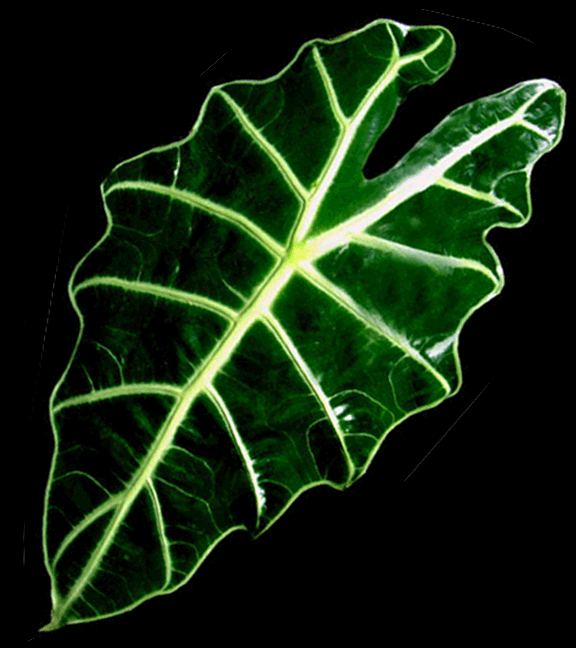
Incorrectly Alocasia x amazonica
A hybrid of
Alocasia longiloba Miq. (formerly known as the synonym A. watsoniana Hort.) x Alocasia sanderiana Hort.
The abbreviation "Miq." indicates the plant was described by Miquel, Friedrich Anton Wilhelm (1811-1871)
Alocasia Frydek and Alocasia Maxkowskii are hybrids
that have different parentage involving Alocasia micholitziana
Alocasia Amazonica has the same parentage as Alocasia mortefontanensis André
Aroid grower John Banta and aroid writer and expert Julius Boos in West Palm Beach, FL were able to trace the hybrid to postman and nursery owner Salvadore Mauro who during the 1950's owned a now defunct nursery in Miami, FL. The nursery was known as the "Amazon Nursery" and Mauro named Alocasia Amazonica after his own business. The name has since been applied for almost 60 years to this popular hybrid bred from Asian parents but others have "borrowed" the name for use on other hybrids or modified the name for commercial purposes.
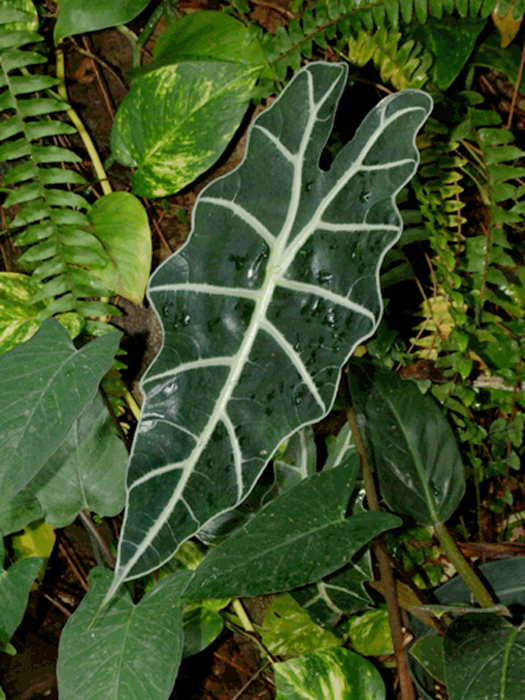 There are several crosses
available today and unless you are willing to pay for a DNA test there
is no way to know the parentage of your plant. Depending on the
parents of the cross the plants often take on different shapes and
sizes which makes growers often wonder what they are growing.
Still the name Alocasia Amazonica came from one man at one small nursery
in Miami, FL and should be applied to only Salvador's hybrid.
There are several crosses
available today and unless you are willing to pay for a DNA test there
is no way to know the parentage of your plant. Depending on the
parents of the cross the plants often take on different shapes and
sizes which makes growers often wonder what they are growing.
Still the name Alocasia Amazonica came from one man at one small nursery
in Miami, FL and should be applied to only Salvador's hybrid.Do an internet search and you will find the National Botanic Garden of Belgium AlocasiaxAmazonica and other sources including Wikipedia and some university websites including the University of Connecticut either currently or have in the past indicated Alocasia x amazonica was described in a scientific paper by botanist Éduard François André (1840-1911). The United States Department of Agriculture (USDA) formerly credited André until November 16, 2009 when they elected to update their webpage to indicate the name is horticultural and is not a legitimate scientific name: Alocasia x Amazonica USDA The University of Connecticut corrected their page to reflect the correct status of the plant on November 20, 2009. Sincethe name Alocasia Amazonica as well as the plant as it is grown today didn't come into existence until the 1950's, more than forty years after André's death, his deserving credit for the name would be highly unlikely.
Evidence provided by Geneviève Ferry who is associated with the Jardins Botaniques de Nancy in France makes it clear André's plant was never described as Alocasia x amazonica as is often reported. Instead André's hybrid was published in Revue Horticole in 1891. The plant was crossed by the brothers Chantrier who were gardeners at Mortefontaine and they used Alocasia lowii and Alocasia sanderiana as the parent plants. André published the plant using the name Alocasia mortefontanensis. Since Alocasia lowii is now correctly known as a natural variation of Alocasia longiloba (see photo below) the plant would technically have the same parents as the plant created in Miami. However, even though researchers have attempted to credit the plant to André he never referred to the hybrid as Alocasia x amazonica. André also named a plant from southeast Asia in honor of the brothers Chantrier which he published in 1901 as Tacca chantrieri André.
In communication with Rafaël Govaerts, a researcher with the Royal Botanic Garden Kew in London, he has elected to indicate the name Alocasia x amazonica Reark, Proc. Florida State Hort. Soc. 20: 326 (1953) is an invalid name (nom. inval.); Royal Botanic Garden Kew/Alocasia Amazonica while the only possible valid name in a scientific paper for the hybrid would be the unplaced (non-accepted) name Alocasia mortefontanensis. Alocasia morefontanensis As you will soon read in a note from botanist Alistair Hay the use of the term Alocasia x Amazonica is also invalid and should not be used.
Some
sources incorrectly indicate Alocasia mortefontanensis may be the same
as
the
smaller
hybrid
plant
sold as
"Alocasia
Polly"
which according to the original growers of that hybrid is correctly Alocasia Poly.
Although sellers have elected to use the
wrong spelling according to Bill Rotolante and his
father Denis who
are the owners of the
nursery where this smaller variation of Alocasia Amazonica was discovered the
name "Poly" was chosen since
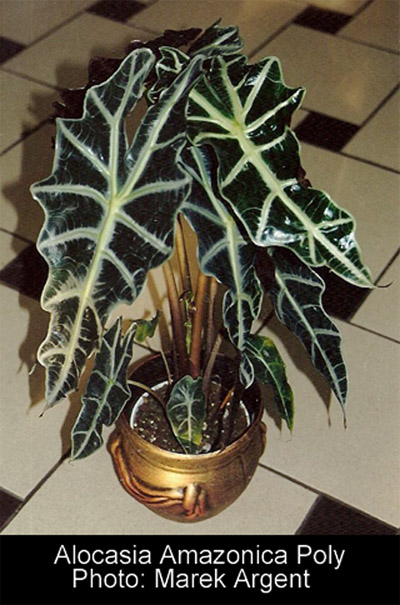 they first thought their smaller
stable hybrid was a polyploid form of Amazonica Amazonica. A
polyploid specimen is one that has an extra set which
doubles the basic number of
chromosomes. Polyploidy can cause oddities including a difference
in size. DNA tests on the plant have since proven this assumption to
be incorrect.
they first thought their smaller
stable hybrid was a polyploid form of Amazonica Amazonica. A
polyploid specimen is one that has an extra set which
doubles the basic number of
chromosomes. Polyploidy can cause oddities including a difference
in size. DNA tests on the plant have since proven this assumption to
be incorrect.
There are over 100 species of Alocasia known to science and all are naturally found in the geographical region composed of Southeast Asia and neighboring island nations of the Pacific Ocean. No Alocasia species has ever been found naturally in Central America, the Caribbean, or South America including the Amazon basin although some species have been imported and now thrive in the area.
Here are three scientific data bases and you will not find the name Alocasia Amazonica on any as a species. The Royal Botanic Garden Kew, London: International Plant Names Index The Missouri Botanical Garden: Tropicos.org/ World Checklist of Selected Plant Families: Kew World Checklist
John Banta is considered a living "legendary" aroid grower respectfully known as "The Banta". If there is any
other living legendary figure in the International Aroid Society
www.Aroid.org other than John it would be
Julius to whom I often turn for clarification on complicated botany
related information! Below is the explanation of the origination
of Alocasia Amazonica as related by John Banta. For those unacquainted
with the names in John's information below these include Dr. Monroe Birdsey
who was a well known botanist as well as some of the original
founders of the IAS (www.Aroid.org),
All are now deceased.
"I guess that it is just another burden that old men must endure. We see facts known to us as true replaced by logical myths.
Unfortunately, Monroe Birdsey, Bob See and Ralph Davis whom all knew Salvadore Mauro, a great plants man are all dead. I was fortunate enough to have visited Sam’s nursery with Monroe. The visit was a result of my questioning Monroe why in the world an Asiatic genus, Alocasia, was given the name, ‘Amazonica’? Monroe’s skill in teaching is illustrated by his response. He made a phone call and then insisted that I accompany him to a friend’s nursery. We drove out to near the Miami airport. Sam lived on about a quarter acre lot just off 36th Street. Behind his small house was a large (about 20 x 30 foot cement block enclosure roofed over with snow fencing. ( for those of you who have never lived in snow country; snow fencing is about 4 feet tall and composed of 1 inch wide wooden slats woven together with 14 gauge galvanized wire leaving about a 1 inch gap between the slats.) His growing area was magical, the cement blocks were covered with algae, moss and ferns and the benches crowded with beautifully grown foliage plants such as Homalomena wallisi ‘Mauro’ that he introduced in the 1950's. Sam was killed in an automobile accident while at work as a postman on one of the three wheeled motor bikes used back in those days. Well, back to our story. As we approached a bench of Alocasia I asked Sam how Alocasia Amazonica got it’s name. He answered ,” I guess it could have been named for a nursery!”
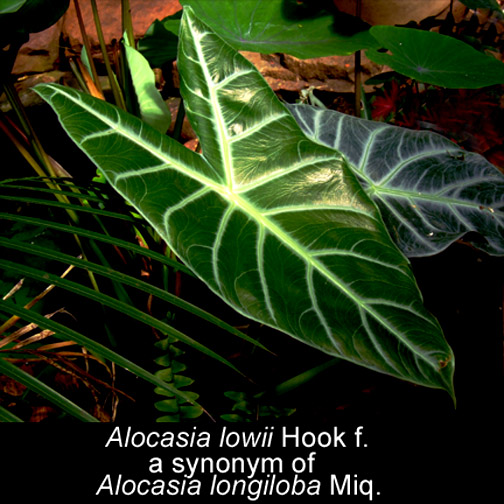 I asked who
made the hybrid? Sam and Monroe had a good laugh at my expense. I had
not noticed the small sign as we entered; ‘Amazon Nursery’ I asked what
the parents were. Sam’s smile quickly darkened. He was upset that it was
erroneously reported to be A. sanderiana X a. lowii whereas it was in
reality A. sanderiana X watsoniana. Years later I remade the hybrid as
Sam suggested I should to verify the parents. All of the seedlings came
up as easily identified as Alocasia Amazonica. I believe without a
doubt that the true origin of Alocasia Amazonica was in Sam’s nursery in
the 1950's. I only wish that some of our departed plants men were
still around for more reasons than to vouch for Sam’s accomplishments."
I asked who
made the hybrid? Sam and Monroe had a good laugh at my expense. I had
not noticed the small sign as we entered; ‘Amazon Nursery’ I asked what
the parents were. Sam’s smile quickly darkened. He was upset that it was
erroneously reported to be A. sanderiana X a. lowii whereas it was in
reality A. sanderiana X watsoniana. Years later I remade the hybrid as
Sam suggested I should to verify the parents. All of the seedlings came
up as easily identified as Alocasia Amazonica. I believe without a
doubt that the true origin of Alocasia Amazonica was in Sam’s nursery in
the 1950's. I only wish that some of our departed plants men were
still around for more reasons than to vouch for Sam’s accomplishments."It also appears some unidentified researcher elected to declare André's Alocasia mortefontanensis to be Alocasia x amazonica due to the popularity of the hybrid plant with growers when in fact it should still be called Alocasia mortefontanensis, at least in the scientific form..
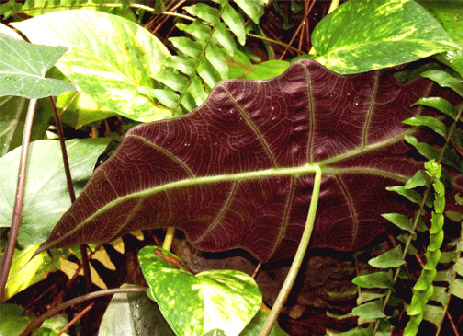 It
is not logical for a well known European hybrid which apparently has
been grown since the late 1800's to be called Alocasia x
amazonica when the reason for the use of the name "Amazonica" is obvious
due to the name of Salvadore Mauro's nursery. To
completely resolve this "mystery" a serious hybrid researcher must grow
both plants again from the originally described parents to learn what is
produced which may prove difficult since the originally used natural
variants are not known for certain.
It
is not logical for a well known European hybrid which apparently has
been grown since the late 1800's to be called Alocasia x
amazonica when the reason for the use of the name "Amazonica" is obvious
due to the name of Salvadore Mauro's nursery. To
completely resolve this "mystery" a serious hybrid researcher must grow
both plants again from the originally described parents to learn what is
produced which may prove difficult since the originally used natural
variants are not known for certain.Since the hybrid was never published or registered by Salvadore Mauro the field is somewhat open to anyone wishing to give the plant a "new" name in an attempt to convince growers they should buy another specimen. As a result you'll find many discussions on plant forums where people wrangle over which "species" any particular specimen might have actually been. Commercial growers anxious to sell even more plants often come up with "new names" including "Alocasia Alligator" and often advertise the plant as a "new species" which is simply incorrect. Regardless of any of the "new" names the plant is not a "new" species but only a hybrid.
Be very wary of the "made-up" and often bad information found on the internet regarding the growth of this plant. Although you can find information on more than a dozen websites declaring Alocasia Amazonica a "species" it simply does not exist in science and is instead a hybrid created by human hands. Even though you can sometimes find the name listed as Alocasia 'Amazonica', to use single quotes indicates the plant is a registered cultivar.
It is now popular method for home and nursery growers to do when then believe they've discovered something "new" to simply make up a name and put it in single quotes in order to make such a claim the plant must be properly registered with the International Aroid Society. The IAS has been designated as the official registrar for all aroid hybrids and cultivars. Since the International Aroid Society controls the cultivar registry all one needs to do to learn about a registered cultivar is visit the IAS website http://www.aroid.org/cultivars/ Just type in the name and you'll find no such registration exists.
Tissue culture is simply cloning. As a result, this is a very confusing group of both species and hybrid plants. I even found the specimen being sold as Alocasia Maxkowskii. I have no idea where that name originated but it is likely the invention of another tissue culture company who felt they had to have some name they could claim for promotional purposes. Besides, it sounds like a botanical name, even though it is not.
 Wild
Alocasia
species
reproduce via the production of an
inflorescence. When an Alocasia is "in flower" the
reference is to the tiny male and female flowers that grow on the
spadix at the center of the inflorescence when the plant is ready to
reproduce. The inflorescence is supported by a stalk known as
the peduncle. The spathe is not a
"flower" but instead is simply a
modified leaf in the shape of a hood. Flowers contain
the
sexual parts of a plant and the spathe
has
no sexual parts since all
those are located on the spadix.
The
spadix is a spike on a thickened fleshy axis which can
produce tiny
flowers.
Once the female flowers on the spadix have
been fertilized by an insect they produce
berries. The berries are then eaten by birds
and rain forest animals that spread the seeds through their
droppings.
Wild
Alocasia
species
reproduce via the production of an
inflorescence. When an Alocasia is "in flower" the
reference is to the tiny male and female flowers that grow on the
spadix at the center of the inflorescence when the plant is ready to
reproduce. The inflorescence is supported by a stalk known as
the peduncle. The spathe is not a
"flower" but instead is simply a
modified leaf in the shape of a hood. Flowers contain
the
sexual parts of a plant and the spathe
has
no sexual parts since all
those are located on the spadix.
The
spadix is a spike on a thickened fleshy axis which can
produce tiny
flowers.
Once the female flowers on the spadix have
been fertilized by an insect they produce
berries. The berries are then eaten by birds
and rain forest animals that spread the seeds through their
droppings.
Hybridized plants are commonly sterile so these hybrids may never reproduce through natural pollination. Since they are very popular and easily sold the growers hire genetic labs to create them in test tubes through a process known as tissue culture which is cloning. Even though pollination is unlikely the plant often reproduces by division when a new plant simply grows from the base of a mature specimen. If you are interested in learning how aroid species reproduce in nature please read this link on natural pollination.
You cannot fail to water Alocasia Amazonica on a regular basis. This is a hybrid of rain forest specimens and requires damp (not muddy) conditions to prosper. Like many Alocasia sp., if planted out doors Alocasia Amazonica will often go dormant when the temperatures drop below 12.75C (55 degrees F) and you may not see it for some months until spring and warmer weather returns. In most cases the specimen will grow again once the temperatures rise and stabilize again. The specimen will not tolerate a freeze!
Due to the genetics of the parent species in many cases these hybrids go dormant even when grown in a home and may stay underground for multiple years. The plant is still alive as long as the tuber is solid and as long as it is in tact the plant will eventually come back to life. The dormancy period is not well understood and some specimens may skip dormancy completely but in most cases is normal. If dormancy begins there is nothing you can do other than allow the plant to complete the natural cycle since the cause is largely genetically based.
The stalks that support each leaf are correctly known as petioles, not stems. This link explains the difference in the stem and the petiole: What is a stem?
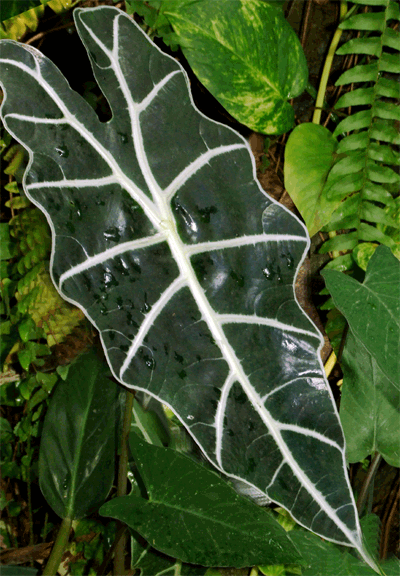 The best growing media for this plant is a well
aerated soil that can drain quickly. You can duplicate this mix with
soil growers
often call "jungle mix" . Make it yourself with a
good "moisture control" potting soil mixed with
bark such as orchid potting media containing charcoal, coarse Perlite™,
peat
moss and finely shredded sphagnum moss. A layer of loose mulch above the soil will give the roots a
natural place to spread as the parent plants would have done in nature.
The best growing media for this plant is a well
aerated soil that can drain quickly. You can duplicate this mix with
soil growers
often call "jungle mix" . Make it yourself with a
good "moisture control" potting soil mixed with
bark such as orchid potting media containing charcoal, coarse Perlite™,
peat
moss and finely shredded sphagnum moss. A layer of loose mulch above the soil will give the roots a
natural place to spread as the parent plants would have done in nature.
Aroid Pollination!
As
it occurs in nature and by any Horticoleulturist
Join the
International Aroid Society:
http://www.exoticrainforest.com/Join%20IAS.html